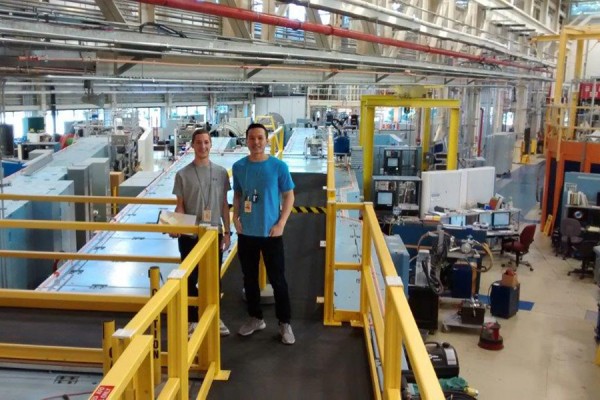 Mitchell DiPasquale and Michael H.L. Nguyen will conduct an experiment next month in the National Institute of Standards and Technology Center for Neutron Research in Gaithersburg, Maryland.
Mitchell DiPasquale and Michael H.L. Nguyen will conduct an experiment next month in the National Institute of Standards and Technology Center for Neutron Research in Gaithersburg, Maryland.
As the summer heat builds, four UWindsor chemistry and biochemistry students are planning a unique August trip. Instead of a typical beach holiday, the small research team, led by professor Drew Marquardt, will head to one of the two North American neutron research facilities to carry out first-of-its-kind research into neutron scattering.
Masters students Mitchell DiPasquale and Michael H.L. Nguyen submitted the successful proposal to use the Neutron Spin Echo (NSE) at the National Institute of Standards and Technology Center for Neutron Research in Gaithersburg, Maryland. Their project is called “Measuring the bending rigidity of a eukaryotic (asymmetric) plasma membrane mimic with Neutron Spin Echo.” They will be joined by fellow graduate researchers Brett Rickeard and Jacqueline Gemus.
Neutron scattering allows scientists to explore the structure and dynamics of materials, down to atomic length scales, as an alternative and compliment to X-rays. Neutrons carry no charge and are magnetic and can be used to advance scientific research in drastic and unique ways, including medical advancements in drug delivery, cancer treatments or even to discover a new class of magnetic material for faster and safer storage of data in cell phones.
“We were a little baffled that our slightly obscure project was one of the few accepted by the academic peer reviewed panel,” says DiPasquale. “In fact, the panel said we were the only suitable candidates to perform this experiment on the latest equipment, based on what we’ve already accomplished in Dr. Marquardt’s lab — it is a real confidence boost.”
The researchers are looking at model mammalian plasma membranes, with a lab-designed asymmetrical membrane. DiPasquale says the neutron beam will help them measure performance down to a width of 50 or 60 atoms and will give them information on how native cell membranes behave.
DiPasquale says their study has implications in all biological interactions.
“We know proteins associate with membranes but how and why that actually occurs is unknown — this is a foundational experiment about processes we know happen, without knowing how they actually happen,” he says.
“The data we’ll gather from using the NSE would be unattainable by other methods, and this is a relatively new method of using neutrons, so it gives us an opportunity to explore something we didn’t think we’d ever get to investigate. That is exciting science.”
The group will receive 11 days of access to the Neutron Spin Echo, which is worth about $5,000 a day. Marquardt says the only Canadian neutron scattering facility was permanently shut down earlier in 2018 and the United States has two facilities, but one is on a one-year scheduled maintenance shutdown, making the success of their proposal extremely impressive.
“We’ll have access to the most complex neutron scattering instruments in the world that can produce non-destructive, highly penetrative beams that are powerful enough look into an engine block without cutting the block in half,” says Dr. Marquardt.
“The incredible part is that hundreds of research projects wanting to use the facility are turned down each year because there is simply not enough beam time to go around, and our project was accepted based on the application that my two grad students submitted as a graduate course assignment.”
Nguyen is looking forward to the opportunity.
“Not many Canadian university students have the opportunity to go on a trip of this calibre,” he says. “This will no doubt allow us to further apply our skills in a more meaningful way.”
The group plans to produce an academic paper with the data collected. Watch this video to better understand the possible scientific applications of neutron scattering.
Sara Elliott
